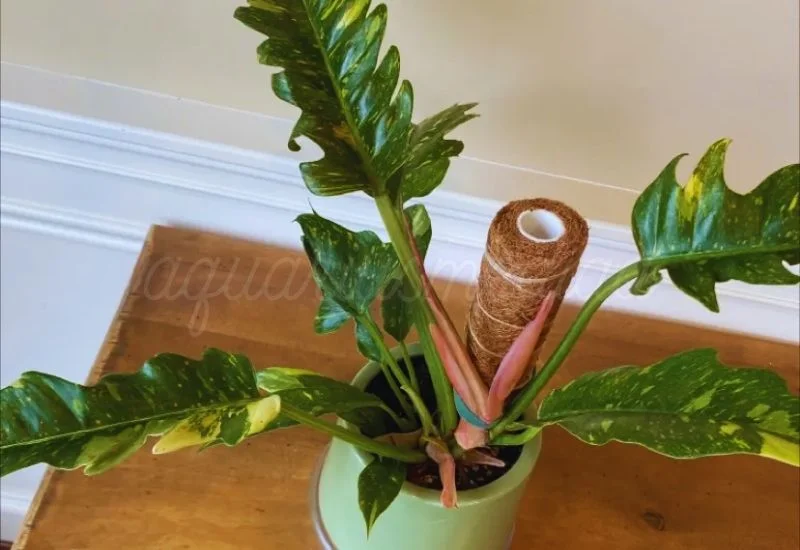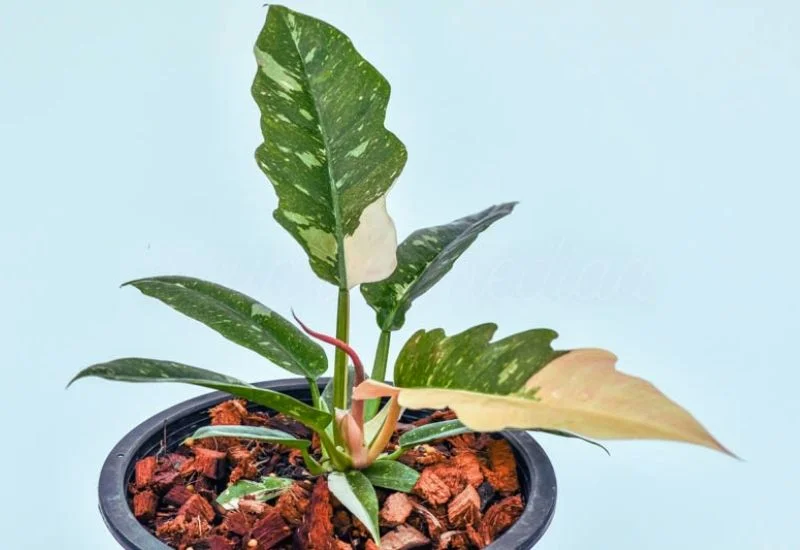In this blog post, you’re going to learn how to easily propagate and care for Philodendron Ring of Fire.
This is a comprehensive guide covering reliable information about different aspects of this variety.
In this post, I’ll cover:
* Interesting Facts
* Propagation
* Repotting
* Care
And
* Solutions to Common Problems
So, if you are looking to propagate and care for Philodendron Ring of Fire, this guide is for you.
Fun Facts
| Common Name | Philodendron Ring of Fire |
| Botanical Name | Philodendron bipinnatifidum x selloum |
| Family | Araceae |
| Plant Type | Perenneial |
| Fruit | Poisonous |
| Mature Size | 8 ft. tall, 6 ft. wide |
| Sun Exposure | Indirect light (partial) |
| Soil Type | Moist and well drained |
| Soil pH | Acidic |
| Native Area | Central and South America (Tropical) |
| Toxic | Toxic to both human and pets |
| Growth | Slow growing (Climibing habit) |
The Philodendron ring of fire displays numerous features of the Philodendron genus. The flexibility of its growing indoors, like the majority of Philodendron species, contributes to the increasing presence of the plant in households.It has a climbing/ trailing habit based on available climbing structures. Besides, its foliage has a combination of vivid colors with numerous variations.
The spectacular feature of Philodendron’s ‘Ring of Fire’ is the leaves of this plant. These are relatively big, shiny, and have a tiny, intricate pattern with shades of green, orange, and red colors.
The vegetative phase of the Philodendron ‘Ring of Fire’ tends to last several months with the active growth phases in the spring and summer. These are the summer months for this plant and during this season, the plant gets to develop new leaves quickly and increases its size mass. So as far as the development of the plant is concerned, it grows all year round, but, not at the same pace in colder and less bright conditions.
This change in growth rate is expected from many tropical species which prefer to have steady warm conditions and their growth rate slows in less conducive climates.
Flowers and Fruits

It is not known for the flowers and fruits. But, in the natural environment can develop small flowers that are not very noticeable. Then these flowers convert into small berry-like fruits. These are poisonous to thehuman and prets.
Benefits
Here are the major benefits of this plant;
Aesthetic Appeal: Its lovely colored green leaves with orange and red shades brings the essence of tropics inside your home.
Air Purification: Like most indoor plants this Philodendron helps in purifying indoor air by neutralizing items such as formaldehyde and benzene.
Low Maintenance: It is not very demanding and can adapt to a vast number of indoor environments without requiring much care and attention. So, it is best from the beginne to advanced gardneres.
Compact Growth: Due to its compactness, it can be used in any given environment, in small rooms, or as part of office equipment as a fashionable and practical accessory.
Adaptability: They prefer a well-draining soil that has plenty of moisture, and can be grown under low to bright indirect light which makes it quite adaptable.
Propagation
Like other Philodendron species, the Ring of Fire is also propagated through the stem cuttings. First of all, a fresh and healthy stem part is selected. This stem part should have two to three leaves and nodes on it. Then, this stem cutting is kept in the water container. You have to prevent bacterial, algal, and fungal growth in the water by changing it regularly.
Now, wait for the root nodes to appear. During this period, water containers should receive warm temperatures, high humidity levels, and indirect sunlight. In a few weeks, the roots will reach upto one inch. This is the time when you can transfer the stem cutting into the soil pot.
Put the stem cutting in the soil pot with loose, aerated, and fertilized soil mixture. Moreover, ensure that the soil mixture is soft and wet so that the small roots can easily spread. You have to maintain the same conditions as mentioned above until the leaves grow on the stem cutting.
Repotting
Ring of Fire is a slow-growing and small-sized plant. That’s why you don’t have to worry about the repotting. However, when you observe sprouting of the roots from the draining holes of the pot, you should go for repotting.
Even in this case, you should wait for the spring or summer. As growth is at its maximum rate in these seasons, they can easily adapt to their new pot. To repot it successfully, you should follow the steps given below:
- Water your Philodendron a day before to make its soil soft and loose.
- Squeeze the pot to remove the soil as much as possible. Moreover, you can use a knife to remove the soil from the pot. You have to remove the plant from the pot without any damage to its roots.
- Buy a new pot that is three inches wider than the previous one.
- Prepare the soil mixture for the plant and fill the lower layer of the pot with it.
- Now, hold your Ring of Fire in the center of the new pot and put the soil around the plant. You don’t have to press soil. Just leave it loose so that the roots can easily spread.
You should water it regularly in the first week and then transfer it to the location where it is kept in your home.
Care
Philodendron Ring of Fire doesn’t need any extra care than the rest of your Philodendrons. You can achieve an optimal growth of your Philodendron through the following conditions:
Soil
You can prepare an ideal soil mixture for your Ring of Fire with the following constituents:
- Potting soil
- Perlite or pumice
- Orchid bark or coir
These three constituents should be mixed in equal amounts. As a result of this mixture, you will get porous, well-aerated, loose, well-draining, and nutrient-rich soil.
Pot
The diameter of the pot for the Philodendron Ring of Fire ranges between 6 to 10 inches. It is recommended to go for the bigger sizes. These pots will be available in different materials like ceramic, plastic, metal, soil terracotta, etc. You just have to ensure that the pot has small holes for drainage purposes.
Water
These are tropical plants, so you have to be very careful when watering them. Firstly, check the top layer of the soil in the pot to see if it is dry. Then, water it deeply so that it can reach the lower layer of the soil in the pot.
Light
These plants require an ample amount of bright but indirect sunlight. It is recommended to provide a minimum of 8 hours of light. For this purpose, you have to keep it in a way that sunlight can reach easily to its pot.
Fertilizer
Plants absorb nutrients from the soil. So, you should provide them with fertilizers to ensure a continuous supply of nutrients. For Ring of Fire, you should provide liquid fertilizers in dilute form every month.
Placement
You have to place your Philodendron in a place where it can receive bright, indirect sunlight. The best place is your little home garden, lawn, washroom, and kitchen. All these places must have a light source.
Most people keep them in front of the windows that are facing the sun from the north. So that they can receive light the whole day; otherwise, the color variegation in the leaves can be lost.
Pruning
These are slow-growing plants. You just have to trim the dead or damaged leaves. Sometimes, these plants have fungal or bacterial infections. In such cases, you will also trim those leaves immediately. But you have to ensure that the knife or pair of scissors are completely sterilized.
Common Problems
Commonly, this Philodendron species is affected by wilting and yellowing of leaves. This is primarily due to the stress from the environmental conditions. So, by regulating the environmental conditions, you can have the normal growth of your Philodendron Ring of Fire.
Pests and Fungal Diseases
The most commonly found pests on these plants are mealybugs, gnats, scales, and spider mites. You should check the leaves for the fluffy material or honeybee residue.
These pests absorb the nutrients from their leaves. In this way, leaves become short of water and food. Due to this, they turn brown, resulting in the death of the plant.
When you keep your plant in damp conditions, you will observe dark brown spots on the stem and leaves. These can be fungal or bacterial infections. You have to remove these infected leaves immediately and separate those infected plants from the healthy ones.
After this, you have to increase the air circulation, decrease the amount of water, and keep it more in indirect sunlight.
Leaves Problems
Brown tips, curling, yellowing, and wilting are some of the main leaf problems of the Philodendron Ring of Fire. Here are some of the leading causes of these problems:
- Too much exposure to indirect sunlight can burn the tips of the leaves.
- Underwatering can also cause the leaves to curl and turn their color to yellow.
- Overwatering can cause wilting and curling of leaves on the lower side.
So, simply by regulating the water conditions and sunlight exposure time, you can solve these leaf problems.
